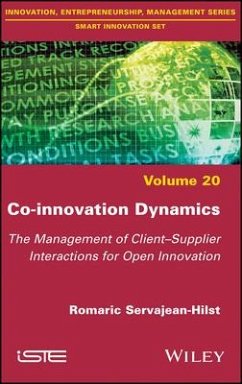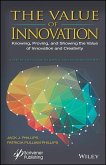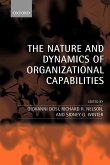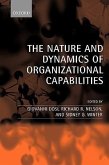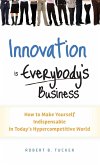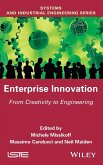Romaric Servajean-Hilst
Co-Innovation Dynamics
The Management of Client-Supplier Interactions for Open Innovation
Romaric Servajean-Hilst
Co-Innovation Dynamics
The Management of Client-Supplier Interactions for Open Innovation
- Gebundenes Buch
- Merkliste
- Auf die Merkliste
- Bewerten Bewerten
- Teilen
- Produkt teilen
- Produkterinnerung
- Produkterinnerung
Over the last 30 years, the pace of innovation has exploded while available resources have become increasingly scarce. Open Innovation is the solution, with client-supplier relationships being the main expedient. However, collaborating in innovation is full of obstacles, from uncertainties in innovation as a whole to difficulties with managing a business relationship. Co-innovation Dynamics, based on a deep-dive ethnographic inquiry enlightened by state-of-the-art management research, presents the daily life story of a collaborative innovation project. Also, based on two other qualitative and…mehr
Andere Kunden interessierten sich auch für
![Collective Dynamics and Territories Collective Dynamics and Territories]() Collective Dynamics and Territories172,99 €
Collective Dynamics and Territories172,99 €![The Value of Innovation The Value of Innovation]() Jack J PhillipsThe Value of Innovation95,99 €
Jack J PhillipsThe Value of Innovation95,99 €![The Nature and Dynamics of Organizational Capabilities The Nature and Dynamics of Organizational Capabilities]() Giovanni Dosi / Richard R. Nelson / Sidney Winter (eds.)The Nature and Dynamics of Organizational Capabilities92,99 €
Giovanni Dosi / Richard R. Nelson / Sidney Winter (eds.)The Nature and Dynamics of Organizational Capabilities92,99 €![The Nature and Dynamics of Organizational Capabilities The Nature and Dynamics of Organizational Capabilities]() Giovanni Dosi / Richard Nelson / Sidney Winter (eds.)The Nature and Dynamics of Organizational Capabilities263,99 €
Giovanni Dosi / Richard Nelson / Sidney Winter (eds.)The Nature and Dynamics of Organizational Capabilities263,99 €![Innovation Is Everybody's Business Innovation Is Everybody's Business]() Robert B TuckerInnovation Is Everybody's Business19,99 €
Robert B TuckerInnovation Is Everybody's Business19,99 €![Enterprise Innovation Enterprise Innovation]() Enterprise Innovation187,99 €
Enterprise Innovation187,99 €![Environmental Innovation and EcoDesign Environmental Innovation and EcoDesign]() Romain DebrefEnvironmental Innovation and EcoDesign186,99 €
Romain DebrefEnvironmental Innovation and EcoDesign186,99 €-
-
-
Over the last 30 years, the pace of innovation has exploded while available resources have become increasingly scarce. Open Innovation is the solution, with client-supplier relationships being the main expedient. However, collaborating in innovation is full of obstacles, from uncertainties in innovation as a whole to difficulties with managing a business relationship. Co-innovation Dynamics, based on a deep-dive ethnographic inquiry enlightened by state-of-the-art management research, presents the daily life story of a collaborative innovation project. Also, based on two other qualitative and quantitative studies on co-innovation management, this book offers lessons and tips on how to manage the dynamics of collaborative innovation in the client-supplier relationship.
Hinweis: Dieser Artikel kann nur an eine deutsche Lieferadresse ausgeliefert werden.
Hinweis: Dieser Artikel kann nur an eine deutsche Lieferadresse ausgeliefert werden.
Produktdetails
- Produktdetails
- Verlag: Wiley
- Seitenzahl: 272
- Erscheinungstermin: 30. Juli 2019
- Englisch
- Abmessung: 236mm x 157mm x 20mm
- Gewicht: 567g
- ISBN-13: 9781786303318
- ISBN-10: 1786303310
- Artikelnr.: 56152734
- Herstellerkennzeichnung
- Libri GmbH
- Europaallee 1
- 36244 Bad Hersfeld
- gpsr@libri.de
- Verlag: Wiley
- Seitenzahl: 272
- Erscheinungstermin: 30. Juli 2019
- Englisch
- Abmessung: 236mm x 157mm x 20mm
- Gewicht: 567g
- ISBN-13: 9781786303318
- ISBN-10: 1786303310
- Artikelnr.: 56152734
- Herstellerkennzeichnung
- Libri GmbH
- Europaallee 1
- 36244 Bad Hersfeld
- gpsr@libri.de
Romaric Servajean-Hilst, PhD, is an entrepreneur and associate researcher at the Management Research Center (i3-CRG) of the Ecole Polytechnique in France. Based on research-action and quantitative studies, his work focuses on the development and management of Open Innovation and disruptive innovation.
Foreword ix
Acknowledgements xiii
Introduction xv
Chapter 1. Open Innovation, or Collaborative Innovation, Between Clients
and Suppliers 1
1.1. Managing client-supplier interactions in Open Innovation 3
1.1.1. Sourcing Open Innovation selecting a partner and choosing the time
of their involvement 4
1.1.2. Configuring the relationship for the innovation project 9
1.1.3. Internally managing the supplier's involvement in the project 13
1.1.4. The pivotal role of Purchasing in Open Innovation 15
1.2. The dynamics of client-supplier cooperation in innovation 18
1.2.1. The effects of the experiment on the client-supplier relationship 20
1.2.2. The evolution of inter-firm relationships 22
1.2.3. The evolution of the relationship environment over time 27
1.2.4. In conclusion, interpretation is needed for reading the dynamics of
Open Innovation 28
Chapter 2. Conditions and Impacts of Client-Supplier Open Innovation
Governance 29
2.1. A benchmark: the performance of the relationship 31
2.1.1. What is performance? 31
2.1.2. Three levels of performance measured in client-supplier Open
Innovation relationships in France 33
2.2. Governance of the relationship, elements, forms and influence on
performance 35
2.2.1. What elements constitute the governance of client-supplier Open
Innovation and how do they influence performance? 35
2.2.2. The governance of Open Innovation: a complex blend 48
2.3. The atmosphere of the relationship, elements, forms and influence on
governance and performance 55
2.3.1. What are the components of the atmosphere of an inter-firm
relationship, and how are they related to performance and governance? 55
2.3.2. The four atmospheres of client-supplier Open Innovation and their
performance 63
2.3.3. Which atmospheres correspond to which type of Open Innovation
governance? 67
2.4. The innovation project and its influence on governance 70
2.4.1. Innovation maturation and the evolution of governance 70
2.4.2. Which type of governances corresponds to which stages of maturity?
72
2.5. Forms of governance to be favored according to the atmosphere of the
relationship and the maturity of the innovation project 73
Chapter 3. The Dynamics of Client-supplier Innovation Interactions -
History and Analysis of a Collaboration 79
3.1. The context of the collaboration 80
3.1.1. DELCAR: an automotive equipment division 80
3.1.2. The Innovation Project at the heart of the relationship: the DELTA
project 82
3.2. History of a client-supplier innovation collaboration 87
3.2.1. Engaging the relationship 87
3.2.2. Exploring the possibilities 93
3.2.3. A "false start" 109
3.2.4. Exploring a potential collaboration 112
3.2.5. Passed gate opening the door to collaboration 133
3.2.6. The negotiation of an agreement 138
3.2.7. Launch of the DELTA collaboration 151
3.2.8. An urgent delay 157
3.2.9. A line, not so straight, until delivery 173
3.2.10. Attainment of the collaboration 188
3.3. Feedback on the collaboration - the contribution of the relational
approach to the "life cycle" and "teleological" approaches to the dynamics
of inter-firm cooperation 195
3.3.1. A model for reading the dynamics 195
3.3.2. The trust-control link in Open Innovation 199
3.3.3. Learning and exchanges in real life 201
3.3.4. Sources and dynamics of the performance 203
Conclusion 207
References 215
Index 233
Acknowledgements xiii
Introduction xv
Chapter 1. Open Innovation, or Collaborative Innovation, Between Clients
and Suppliers 1
1.1. Managing client-supplier interactions in Open Innovation 3
1.1.1. Sourcing Open Innovation selecting a partner and choosing the time
of their involvement 4
1.1.2. Configuring the relationship for the innovation project 9
1.1.3. Internally managing the supplier's involvement in the project 13
1.1.4. The pivotal role of Purchasing in Open Innovation 15
1.2. The dynamics of client-supplier cooperation in innovation 18
1.2.1. The effects of the experiment on the client-supplier relationship 20
1.2.2. The evolution of inter-firm relationships 22
1.2.3. The evolution of the relationship environment over time 27
1.2.4. In conclusion, interpretation is needed for reading the dynamics of
Open Innovation 28
Chapter 2. Conditions and Impacts of Client-Supplier Open Innovation
Governance 29
2.1. A benchmark: the performance of the relationship 31
2.1.1. What is performance? 31
2.1.2. Three levels of performance measured in client-supplier Open
Innovation relationships in France 33
2.2. Governance of the relationship, elements, forms and influence on
performance 35
2.2.1. What elements constitute the governance of client-supplier Open
Innovation and how do they influence performance? 35
2.2.2. The governance of Open Innovation: a complex blend 48
2.3. The atmosphere of the relationship, elements, forms and influence on
governance and performance 55
2.3.1. What are the components of the atmosphere of an inter-firm
relationship, and how are they related to performance and governance? 55
2.3.2. The four atmospheres of client-supplier Open Innovation and their
performance 63
2.3.3. Which atmospheres correspond to which type of Open Innovation
governance? 67
2.4. The innovation project and its influence on governance 70
2.4.1. Innovation maturation and the evolution of governance 70
2.4.2. Which type of governances corresponds to which stages of maturity?
72
2.5. Forms of governance to be favored according to the atmosphere of the
relationship and the maturity of the innovation project 73
Chapter 3. The Dynamics of Client-supplier Innovation Interactions -
History and Analysis of a Collaboration 79
3.1. The context of the collaboration 80
3.1.1. DELCAR: an automotive equipment division 80
3.1.2. The Innovation Project at the heart of the relationship: the DELTA
project 82
3.2. History of a client-supplier innovation collaboration 87
3.2.1. Engaging the relationship 87
3.2.2. Exploring the possibilities 93
3.2.3. A "false start" 109
3.2.4. Exploring a potential collaboration 112
3.2.5. Passed gate opening the door to collaboration 133
3.2.6. The negotiation of an agreement 138
3.2.7. Launch of the DELTA collaboration 151
3.2.8. An urgent delay 157
3.2.9. A line, not so straight, until delivery 173
3.2.10. Attainment of the collaboration 188
3.3. Feedback on the collaboration - the contribution of the relational
approach to the "life cycle" and "teleological" approaches to the dynamics
of inter-firm cooperation 195
3.3.1. A model for reading the dynamics 195
3.3.2. The trust-control link in Open Innovation 199
3.3.3. Learning and exchanges in real life 201
3.3.4. Sources and dynamics of the performance 203
Conclusion 207
References 215
Index 233
Foreword ix
Acknowledgements xiii
Introduction xv
Chapter 1. Open Innovation, or Collaborative Innovation, Between Clients
and Suppliers 1
1.1. Managing client-supplier interactions in Open Innovation 3
1.1.1. Sourcing Open Innovation selecting a partner and choosing the time
of their involvement 4
1.1.2. Configuring the relationship for the innovation project 9
1.1.3. Internally managing the supplier's involvement in the project 13
1.1.4. The pivotal role of Purchasing in Open Innovation 15
1.2. The dynamics of client-supplier cooperation in innovation 18
1.2.1. The effects of the experiment on the client-supplier relationship 20
1.2.2. The evolution of inter-firm relationships 22
1.2.3. The evolution of the relationship environment over time 27
1.2.4. In conclusion, interpretation is needed for reading the dynamics of
Open Innovation 28
Chapter 2. Conditions and Impacts of Client-Supplier Open Innovation
Governance 29
2.1. A benchmark: the performance of the relationship 31
2.1.1. What is performance? 31
2.1.2. Three levels of performance measured in client-supplier Open
Innovation relationships in France 33
2.2. Governance of the relationship, elements, forms and influence on
performance 35
2.2.1. What elements constitute the governance of client-supplier Open
Innovation and how do they influence performance? 35
2.2.2. The governance of Open Innovation: a complex blend 48
2.3. The atmosphere of the relationship, elements, forms and influence on
governance and performance 55
2.3.1. What are the components of the atmosphere of an inter-firm
relationship, and how are they related to performance and governance? 55
2.3.2. The four atmospheres of client-supplier Open Innovation and their
performance 63
2.3.3. Which atmospheres correspond to which type of Open Innovation
governance? 67
2.4. The innovation project and its influence on governance 70
2.4.1. Innovation maturation and the evolution of governance 70
2.4.2. Which type of governances corresponds to which stages of maturity?
72
2.5. Forms of governance to be favored according to the atmosphere of the
relationship and the maturity of the innovation project 73
Chapter 3. The Dynamics of Client-supplier Innovation Interactions -
History and Analysis of a Collaboration 79
3.1. The context of the collaboration 80
3.1.1. DELCAR: an automotive equipment division 80
3.1.2. The Innovation Project at the heart of the relationship: the DELTA
project 82
3.2. History of a client-supplier innovation collaboration 87
3.2.1. Engaging the relationship 87
3.2.2. Exploring the possibilities 93
3.2.3. A "false start" 109
3.2.4. Exploring a potential collaboration 112
3.2.5. Passed gate opening the door to collaboration 133
3.2.6. The negotiation of an agreement 138
3.2.7. Launch of the DELTA collaboration 151
3.2.8. An urgent delay 157
3.2.9. A line, not so straight, until delivery 173
3.2.10. Attainment of the collaboration 188
3.3. Feedback on the collaboration - the contribution of the relational
approach to the "life cycle" and "teleological" approaches to the dynamics
of inter-firm cooperation 195
3.3.1. A model for reading the dynamics 195
3.3.2. The trust-control link in Open Innovation 199
3.3.3. Learning and exchanges in real life 201
3.3.4. Sources and dynamics of the performance 203
Conclusion 207
References 215
Index 233
Acknowledgements xiii
Introduction xv
Chapter 1. Open Innovation, or Collaborative Innovation, Between Clients
and Suppliers 1
1.1. Managing client-supplier interactions in Open Innovation 3
1.1.1. Sourcing Open Innovation selecting a partner and choosing the time
of their involvement 4
1.1.2. Configuring the relationship for the innovation project 9
1.1.3. Internally managing the supplier's involvement in the project 13
1.1.4. The pivotal role of Purchasing in Open Innovation 15
1.2. The dynamics of client-supplier cooperation in innovation 18
1.2.1. The effects of the experiment on the client-supplier relationship 20
1.2.2. The evolution of inter-firm relationships 22
1.2.3. The evolution of the relationship environment over time 27
1.2.4. In conclusion, interpretation is needed for reading the dynamics of
Open Innovation 28
Chapter 2. Conditions and Impacts of Client-Supplier Open Innovation
Governance 29
2.1. A benchmark: the performance of the relationship 31
2.1.1. What is performance? 31
2.1.2. Three levels of performance measured in client-supplier Open
Innovation relationships in France 33
2.2. Governance of the relationship, elements, forms and influence on
performance 35
2.2.1. What elements constitute the governance of client-supplier Open
Innovation and how do they influence performance? 35
2.2.2. The governance of Open Innovation: a complex blend 48
2.3. The atmosphere of the relationship, elements, forms and influence on
governance and performance 55
2.3.1. What are the components of the atmosphere of an inter-firm
relationship, and how are they related to performance and governance? 55
2.3.2. The four atmospheres of client-supplier Open Innovation and their
performance 63
2.3.3. Which atmospheres correspond to which type of Open Innovation
governance? 67
2.4. The innovation project and its influence on governance 70
2.4.1. Innovation maturation and the evolution of governance 70
2.4.2. Which type of governances corresponds to which stages of maturity?
72
2.5. Forms of governance to be favored according to the atmosphere of the
relationship and the maturity of the innovation project 73
Chapter 3. The Dynamics of Client-supplier Innovation Interactions -
History and Analysis of a Collaboration 79
3.1. The context of the collaboration 80
3.1.1. DELCAR: an automotive equipment division 80
3.1.2. The Innovation Project at the heart of the relationship: the DELTA
project 82
3.2. History of a client-supplier innovation collaboration 87
3.2.1. Engaging the relationship 87
3.2.2. Exploring the possibilities 93
3.2.3. A "false start" 109
3.2.4. Exploring a potential collaboration 112
3.2.5. Passed gate opening the door to collaboration 133
3.2.6. The negotiation of an agreement 138
3.2.7. Launch of the DELTA collaboration 151
3.2.8. An urgent delay 157
3.2.9. A line, not so straight, until delivery 173
3.2.10. Attainment of the collaboration 188
3.3. Feedback on the collaboration - the contribution of the relational
approach to the "life cycle" and "teleological" approaches to the dynamics
of inter-firm cooperation 195
3.3.1. A model for reading the dynamics 195
3.3.2. The trust-control link in Open Innovation 199
3.3.3. Learning and exchanges in real life 201
3.3.4. Sources and dynamics of the performance 203
Conclusion 207
References 215
Index 233

